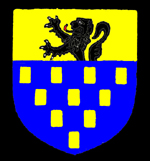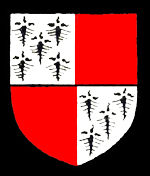This manor was first recorded in 1053 when it was owned by Ulf, whose widow Adelitha married the Oswulf, son of Fran, recorded in 1086 in the Domesday Book. This information comes from a charter held by the Abbey of Saint Albans which alleged that Oswulf and Adelitha granted the manor to the Abbey in 1064. Some doubt has been cast over such grants as being later attempts by religious institutions to claim land - the grant may, in this case, be a mid 13th century forgery.
The overlordship of the manor was given by de Tosny to his daughter, wife of Hubert de Rye. Her son Henry was succeeded by his nephew Hubert whose lands were divided, on his death, between his daughters Alina Marshal and Isabel de Cressie with Alina receiving the Manor of Studham which then remained in the Marshal family until 1316 when William Marshal's widow Ela, who then married Robert FitzPayne, inherited. She was succeeded by her sister-in-law Hawisia who had married Robert de Morley. The de Morleys held Studham Manor until at least 1428. At some point after this the Manor must have been appropriated by the Crown as, in 1606, it was stated to be held of the King.
The first recorded tenant of the manor, after Baldric, was Walter de Basingham in the mid 13th century. By 1283 William de Botlesford held the manor from the Marshals and his family remained tenants until 1343 when it was sold to Henry de Burghersh. The de Burghersh family are last mentioned as holding the manor in 1355 and in 1367 John Hawle conveyed it to William Clipsham. By 1428 it was held by Nicholas Carew and, by 1492 was in the hands of the Lucy family.

Dormer coat of arms
In 1549 William Lucy conveyed half the manor to Sir Robert Dormer. His great-great grandson, Robert Dormer became Earl of Carnarvon in the early 17th century. The family must at some point have acquired the other half of the manor because in the late 17th century the manor passed, via Elizabeth Dormer to her husband Philip Stanhope, Earl of Chesterfield.

Stanhope coat of arms
The second son of Chesterfield's son Philip, Third Earl, was granted Studham manor in a family settlement , by which time it was called Studham and Hudnall and, in 1738, it was sold by his trustees as Hudnall Manor to Elizabeth Dyson. In 1778 Jeremiah Dyson conveyed the manor to William Bray, who later sold it to Thomas Poynder and he, in 1808, to John William, Earl of Bridgewater from whom it descended to Earl Brownlow who held it in the early 20th century..
A succession of Law of Property Acts in the 1920s extinguished all manorial incidents, courts and copyhold tenure of land. This effectively abolished manors in all but name.
The medieval manor house stood on the site of Manor Farm, itself a 17th century structure. Evidence for the medieval manor being here is seen in the surviving moat [Historic Environment Record Number 3131]. The moat is recorded in the 13th century and was constructed by Walter de Basingham, and seems to have been sub-circular or sub-oval in shape; the surviving part, east of the house, forms an angular crescent shape. A linear pond to the north of the moat, and an irregular pond west of the farmyard, do not appear to have had any connection to the moat.